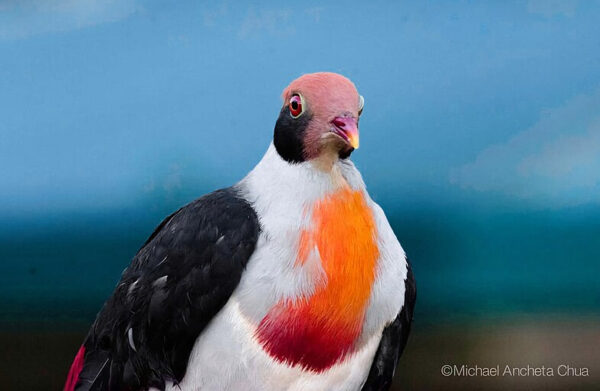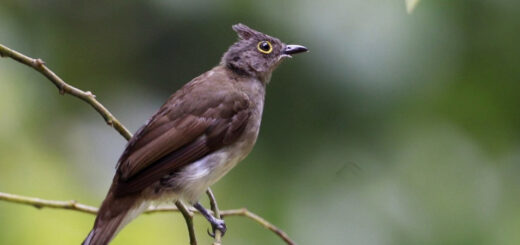The Flame-Breasted Fruit Dove

The Philippines, a country known for its rich biodiversity, is home to a myriad of unique and colorful wildlife species, one of which is the Flame-breasted Fruit Dove (Ptilinopus marchei). This striking bird, a member of the dove and pigeon family, stands out not only because of its vibrant plumage but also due to its endemism—meaning it is found nowhere else in the world but in the Philippines. For bird enthusiasts, nature lovers, and conservationists alike, the Flame-breasted Fruit Dove is a symbol of the island nation’s diverse natural heritage and the urgent need to protect its fragile ecosystems.
A Brief Introduction to the Flame-Breasted Fruit Dove
The Flame-breasted Fruit Dove is a fairly large dove known for its bold and eye-catching colors. Its most distinguishing feature is its brilliant flame-orange breast, which contrasts beautifully with pale gray from the belly to the sides of the chest and neck, with a sooty back and cheek, and a pink crown and mark across the flight feathers. Its vibrant plumage makes it one of the more striking birds in the Philippines tropical forests.
This species is a member of the Ptilinopus genus, which contains other fruit doves that are found across the Pacific and Southeast Asia. Like its relatives, the Flame-breasted Fruit Dove primarily feeds on a diet of fruits, berries, and seeds, often found in the dense canopies of the forests it inhabits.
Where to Find the Flame-Breasted Fruit Dove
The Flame-breasted Fruit Dove is endemic to the Philippines, with sightings primarily concentrated in the islands of Luzon, Catanduanes, and Polillo. These doves are typically found in lowland and montane forests, often in areas with dense vegetation. They thrive in tropical rainforests, which provide ample food sources and the perfect environment for nesting.
Due to its habitat preference, this species is often associated with areas of pristine, undisturbed forest. Unfortunately, such habitats are increasingly threatened by deforestation and other forms of habitat destruction, making the future of this species uncertain.
Behavior and Diet
As a fruit-eating bird, the Flame-breasted Fruit Dove plays a crucial ecological role in the forests it inhabits. It helps in seed dispersal, ensuring the growth of a variety of fruit-bearing plants. By consuming fruits like figs and berries and then spreading their seeds, the dove indirectly aids in maintaining the health and diversity of the forest ecosystem.
The dove is known to be a relatively quiet bird, typically foraging alone or in small groups. Its flight is fast and direct, though it is not particularly known for long-distance travel. Its diet consists mainly of the fruits it finds in the canopy, and it feeds both during the day and at dusk, making it an essential part of the forest’s food web.
Conservation Status: A Species at Risk
Despite its stunning appearance, the Flame-breasted Fruit Dove faces significant threats in its native habitat. The primary danger to this species is habitat loss due to deforestation. Large swathes of forest in the Philippines have been cleared for agriculture, logging, and urban development. This destruction not only reduces the availability of food and nesting sites for the doves but also isolates populations, making it more difficult for them to find mates and breed successfully.
Another challenge faced by the Flame-breasted Fruit Dove is illegal hunting. In some regions, doves and other bird species are captured for the illegal pet trade, which poses a serious threat to their population. While hunting and capturing wild birds are illegal in the Philippines, enforcement remains a challenge, and this bird’s vibrant plumage makes it particularly attractive to poachers.
As of now, the International Union for Conservation of Nature (IUCN) lists the Flame-breasted Fruit Dove as a species of Least Concern, but conservationists warn that its population is in decline due to the aforementioned threats. There is an urgent need for continued conservation efforts, both in terms of habitat protection and legal enforcement, to ensure the survival of this beautiful bird.
Protecting the Flame-Breasted Fruit Dove
To protect the Flame-breasted Fruit Dove and other endemic species of the Philippines, concerted efforts are needed to preserve the country’s remaining forests. This includes creating more protected areas, improving forest management practices, and strengthening laws to prevent illegal logging and poaching.
Organizations, both local and international, are working hard to raise awareness about the importance of preserving the Philippines rich biodiversity. Education, ecotourism, and community involvement are essential components in these conservation efforts. When local communities are educated about the value of wildlife and ecosystems, they are more likely to engage in activities that help protect these species, including the Flame-breasted Fruit Dove.
The Future of the Flame-Breasted Fruit Dove
The Flame-breasted Fruit Dove is more than just a colorful and beautiful bird. It is an indicator of the health of the Philippines forest ecosystems and a symbol of the country’s natural wealth. By protecting the habitats where it lives, we ensure the survival of not just this species, but also countless other plants and animals that depend on the same environment.
For future generations to witness the vibrant beauty of the Flame-breasted Fruit Dove, it is essential that we continue to advocate for the preservation of the Philippines unique biodiversity. Every effort counts, whether it’s supporting conservation organizations, spreading awareness about the importance of biodiversity, or taking part in sustainable practices that protect these natural treasures.
References:
https://en.wikipedia.org/wiki/Flame-breasted_fruit_dove










